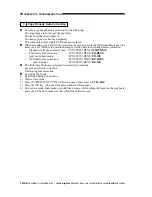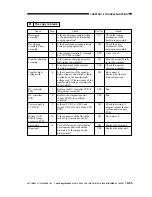
CHAPTER 14 TROUBLESHOOTING
14-38
COPYRIGHT © 1999 CANON INC. CANON imageRUNNER 400/330 REV.0 JAN. 1999 PRINTED IN JAPAN (IMPRIME AU JAPON)
2
The copy is too light (including solid black areas).
Cause
Action
End.
Insert the transfer roller
unit fully.
Check the transfer roller
unit.
Replace the transfer
roller.
Correct the spring
position, or replace the
spring.
The paper may be
moist. Instruct the
user on the correct
method of storage.
Explain to the user
that the use of paper
not recommended by
Canon may not bring
about the best results.
Check to make sure that
the transfer guide is not
in contact with metal
areas of the feeding
assembly (e.g., side
plate).
1. Check the high-
voltage cord for
conductivity. (The
resistance of the
transfer high-voltage
cord is about 10 K
Ω
.)
2. Check the high-
voltage transformer
on the DC controller
PCB.
Step
1
2
3
4
5
6
7
8
Yes/No
YES
NO
NO
YES
YES
NO
YES
YES
NO
Check
Perform the Image Adjustment
Basic Procedure. Is the problem
corrected?
Check to make sure that the pattern
print is placed correctly when
executing
FUNCTION>DENS>PD-ME, DZ-
ME.
Turn off the power switch, and
open the front door. Is the image on
the surface of the photosensitive
drum more or less normal?
Is the transfer roller unit fully
inserted?
Is leakage noted in the transfer
roller unit?
Check the transfer charging roller
for dirt, cracks, and scratches.
Are the position and the condition
of the transfer charging roller
locking spring correct?
Try fresh (out of package) copy
paper. Is the problem corrected?
Set the feeding assembly in feeding
position, and measure the
resistance between the transfer
guide and the base (metal area) of
the transfer charging assembly rail
with a meter. Is it 0
Ω
?
Transfer Transfer
roller
unit
Copy
paper
Transfer
guide
High-
voltage
cord, High-
voltage
transformer,
DC
controller
PCB
Toner
level
detecting
















































